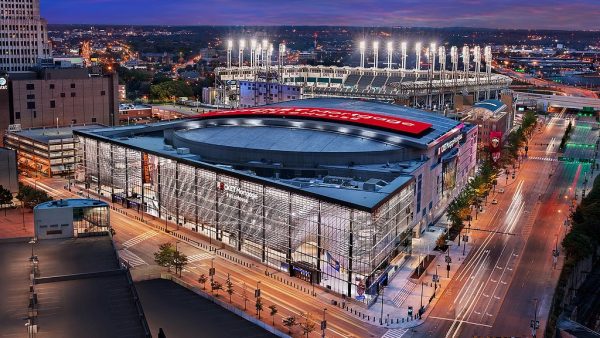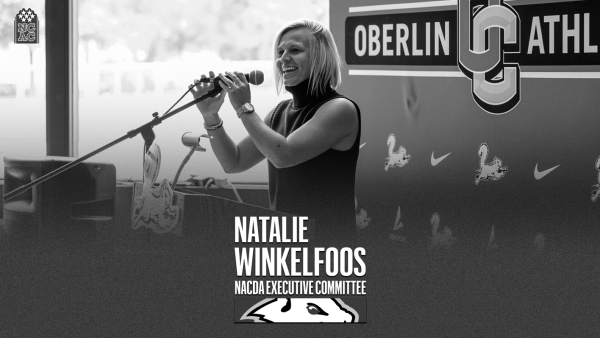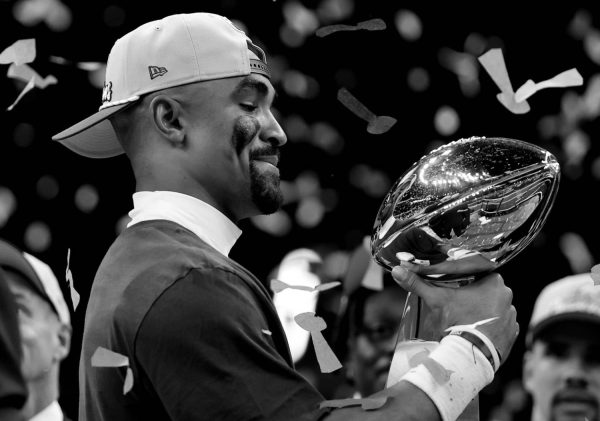Philanthropy Lifts Athletics to Next Level
The men’s and women’s tennis teams and softball team were welcomed to Amway Center two weeks ago to catch an Orlando Magic and Philadelphia 76ers game and meet fellow Obie Jeff Weltman, OC ’87, president of basketball operations for Orlando. As the former Oberlin basketball player reminisced about sitting in Wilder Bowl with his buddies in the springtime, I felt an overwhelming sense of gratitude for the opportunities our athletics department continuously provides its student-athletes.
Just two days before the game, Eastern Michigan University announced it will cut four sports at the conclusion of the semester: men’s swimming and diving, wrestling, women’s tennis, and softball. The reduction will affect 58 male student-athletes and 25 female student-athletes, but it will save the school an estimated $2.4 million. I empathize with the student-athletes at EMU — I went to high school with an athlete on EMU’s women’s swimming and diving team and an athlete on the men’s team. But I also feel relief. Despite the $5 million budget deficit Oberlin faces, our athletic department continues to grow every year thanks to its philanthropic donors.
“I guess you can say we’re generating revenue through enrollment and fundraising,” Delta Lodge Director of Athletics and Physical Education Natalie Winkelfoos said. “I want to control our own destiny. I don’t want to ask for handouts from the College. I don’t want athletics to ever be a drain on the institution. Athletics should be a source of energy and pride for Oberlin.”
Student-athletes — including myself — use the Austin E. Knowlton Athletics Complex and other facilities on a daily basis, yet how many of us are aware that most if not all of these state-of-the-art facilities were made possible because of the generosity of Heisman Club members, alumni, parents, friends, and other benefactors? Admittedly, I assumed the College paid for most of it until I was three semesters into my college experience.
Since 2012, when former President Marvin Krislov named Winkelfoos the new athletic director, Winkelfoos has worked closely with the Office of Development to raise over $30 million as part of the Oberlin Illuminate campaign. The money went toward Knowlton — completed in September 2014 — and the Pat ’63 and Merrill Shanks ’61 Health & Wellness Center, which includes Carr Pool — scheduled to open this August.
Knowlton includes the all-weather, multipurpose Dick Bailey Field, a renovated press box, a locker room building for all outdoor sports, and a building used for meetings, banquets, and other social events. It’s named after the Austin E. Knowlton Foundation, which provides grants and donations to colleges and universities across the Midwest. Originally the foundation gifted Oberlin athletics with $5 million to replace Savage Stadium.
“We told [them] the story behind what we’re planning on doing,” Winkelfoos said. “They came for a site visit, saw our stadium, and realized that was where they wanted to be a player in the game for us. It’s awesome because they’re not alumni. There’s a soft connection between them and us. They just ended up falling in love with Oberlin and what it stands for.”
Shortly after construction began, Winkelfoos realized she would need more money and convinced the foundation to donate another $3 million. Alumni — many of whom were athletes — covered the rest of the cost. Before the installation of the turf field, the football team used the stadium five or so times a year for home football games, but that was it. Teams couldn’t practice on the grass field, especially in rain or snow. While men’s teams had locker rooms near their respective facilities, the women’s teams had to drag their equipment to and from Philips gym.
The other piece of the Oberlin Illuminate project, the Health & Wellness Center, will be a space for everybody on campus, not just members of varsity sports teams. Although the men’s and women’s swimming and diving teams will practice in Carr Pool, some lanes will be reserved for recreational users. The hope, Winkelfoos said, is to bridge the athlete/non-athlete divide. She said the new facility is a recruitment tool for students interested in keeping up with their fitness or exploring classes like yoga or spinning.
“Philips gym was built in 1971, a year before Title IX,” Winkelfoos said. “Now there’s more of a concentration — not just by the College but by the world — on being physically and mentally well. Our facility is busy, and if you’re not working out with your team, you’re bumping into people and not having the experience you want.”
The Heisman Club, created in 1978 to honor legendary former Oberlin Football Head Coach John William Heisman, has done its best to renovate Philips. Club members meet formally three times a year, brainstorming ways to enhance the athletic experience for students of the College and community members. The Heisman Club, led by Carla Freyvogel, OC ‘79, remodeled the main lobby, second-floor classroom, and conference room in Philips. In addition, the club pays for class instructors, equipment, and other resources. The key to the Heisman Club’s success in getting people to donate, Winkelfoos said, is to get them to buy in.
“It’s about vision and reconnecting [donors] to their experience as a student-athlete,” Winkelfoos said. “It’s about listening and finding the value proposition for them. It’s really all about relationship-building.”
Trustee Steve Dolcemaschio and his family have bought into the athletic department’s vision. A year after baseball alum Jack Dunn, OC ’10, and his family gifted the baseball program with a new press box, Dolcemaschio played a big role in making it possible for Dill Field’s dirt infield to be replaced with synthetic field turf. Dolcemaschio’s son, Blaise, OC ’16, earned 106 starts behind the dish over his four-year career for Coach Adrian Abrahamowicz. In the past six years, the Yeomen have made it to the conference tournament four times and broken several program records.
“The baseball parents as a collection are amazing,” Winkelfoos said. “They’ve really helped that program grow. That’s an example of how philanthropy can actually help you find success. Of course, it always takes the right people, but once you get that mindset dialed in, the sky is the limit. I think we’re starting to see that with the softball program.”
Prior to the softball team’s doubleheader tomorrow against Denison University, the official dedication of Dolcemaschio Stadium will take place. Dolcemaschio and his wife, Julie, made it possible to have stadium seating and a press box installed at Culhane Field. In addition, the Goldring Family Foundation — named after Becky Goldring, OC ’09 — and Ernest and Josie Newborn — parents of baseball alum Josh Newborn, OC ’16 — will be honored on each dugout.
Over the past decade, the athletic facilities at Oberlin have been remodeled into some of the nicest facilities in all of Division III, and it’s important to recognize and appreciate those who have helped make it all possible. As a direct result of their time and effort, many have helped transformed Oberlin athletics from a laughing stock into a story of success and goodwill.
Winkelfoos was one of four athletic directors from NCAA Division III who earned the title of Under Armour Athletic Director of the Year last month. Winkelfoos said the award represents the holistic success of the Oberlin athletics community.
“This isn’t an award about me,” Winkelfoos said. “It’s an award about the growth of Oberlin athletics. People are recognizing the good work we’re doing here. This is my 12th year here, and this is the strongest coaching staff we’ve ever had. I’m just as grateful for them as I am the Heisman Club and [other donors]. They’re recruiting the right kind of scholar athletes, which is where it all begins.”







